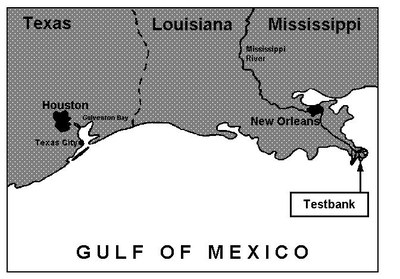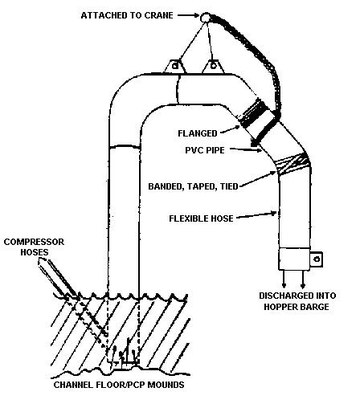1980 - Testbank
| Year | 1980 |
| Vessel | Testbank |
| Location | Mississipi Estuary, USA |
| Cargo type | Package |
| Chemicals | HYDROGEN BROMIDE , PENTACHLOROPHENOL |
Summary
On July 22, 1980, at approximately 8.45pm, the outbound container ship M/V Testbank of German registry and the inbound carrier M/V Sea Daniel of Panamanian registry, collided, probably due to improper actions by the steersman on the Sea Daniel. This collision occurred at the Mississippi River Gulf Outlet, U.S.A. (Figure 1), 3/4 mile from Shell Beach, Louisiana (population approximately 2,000). The Sea Daniel's port bow raked the port topside containers of the Testbank. Four containers were knocked into an 11 metre channel and four others were extensively damaged onboard.
As the Testbank proceeded to anchor 1/2 mile seaward from the collision site, a white haze with a noxious odour of rotten onions enveloped the ship.
The Sea Daniel immediately dropped anchor close to the collision site. It had sustained minimal hull damage but began experiencing strong fumes. The master of the vessel requested permission to resume the inbound voyage to the New Orleans Bulk Terminal. Since the vessel had reported "no injuries, no pollution and minor damage", the Captain of the Port granted this permission. However, at the time he was not told that some of the Testbank's cargo had fallen onto the bow area of the Sea Daniel, which included 15 damaged bags of pentachlorophenol.
After the collision, a survey of the cargo damaged on the Testbank showed that four containers were knocked overboard. Although other hazardous cargo was also lost or still damaged onboard, such as vinyl resin, lube oil, ethyl mercaptan, the greatest concern were 18 tons of pentachlorophenol in 23kg bags in containers as well as steel drums of hydrogen bromide gas solution (hydrobromic acid),
Narrative
On July 22, 1980, at approximately 8.45pm, the outbound container ship M/V Testbank of German registry and the inbound carrier M/V Sea Daniel of Panamanian registry, collided, probably due to improper actions by the steersman on the Sea Daniel. This collision occurred at the Mississippi River Gulf Outlet, U.S.A. (Figure 1), 3/4 mile from Shell Beach, Louisiana (population approximately 2,000). The Sea Daniel's port bow raked the port topside containers of the Testbank. Four containers were knocked into an 11 metre channel and four others were extensively damaged onboard.
As the Testbank proceeded to anchor 1/2 mile seaward from the collision site, a white haze with a noxious odour of rotten onions enveloped the ship.
The Sea Daniel immediately dropped anchor close to the collision site. It had sustained minimal hull damage but began experiencing strong fumes. The master of the vessel requested permission to resume the inbound voyage to the New Orleans Bulk Terminal. Since the vessel had reported "no injuries, no pollution and minor damage", the Captain of the Port granted this permission. However, at the time he was not told that some of the Testbank's cargo had fallen onto the bow area of the Sea Daniel, which included 15 damaged bags of pentachlorophenol.
After the collision, a survey of the cargo damaged on the Testbank showed that four containers were knocked overboard. Although other hazardous cargo was also lost or still damaged onboard, such as vinyl resin, lube oil, ethyl mercaptan, the greatest concern were 18 tons of pentachlorophenol in 23kg bags in containers as well as steel drums of hydrogen bromide gas solution (hydrobromic acid),
Resume
Shortly after the collision when the white haze of hydrogen bromide enveloped the Testbank, the crew secured the ship's ventilation system and took shelter below deck. An early attempt by the crew wearing breathing apparatus to survey the topside damage failed due to poor lighting and the chemical haze. The white haze was carried by the prevailing winds up the channel and into the village of Shell Beach. Alarmed citizens complained of the odour and the sheriff began an evacuation which ultimately resulted in 75 residents being moved.
After the ship was surveyed, the following priorities were set:
- dispatch heavy equipment (derrick and hopper barges) to stabilize the Testbank's deck cargo;
- analyze the water to determine if it was safe for divers;
- locate and raise any pentachlorophenol which may have fallen into the water;
- recover all containers from the water;
- remove damaged containers from the Testbank.
On July 23, the collision site was surveyed by helicopter which showed that the hazardous cargo was either scattered on the deck or along both banks of the channel. The following conclusions were drawn:
- the hydrobromic acid and ethyl mercaptan leaks appeared to have stopped and another survey would be made to confirm this;
- a 20-ft container of pentachlorophenol was missing and presumed overboard;
- many bags of vinyl resin were spilled from damaged containers; this resin was a neutral compound;
- one container of general cargo and one lube oil tank were visible in the water; the oil tank was leaking; one additional 40-ft container of non-hazardous cargo was missing;
- hydrobromic acid drums were in the water, but the quantity unknown.
On Day 1, following the collision, a survey boat commenced scanning the channel bottom with a recording fathometer. Sweeps were made one mile above and below the collision site. Any objects located were marked with buoys for further investigation by divers.
On Day 3, arrangements for diving teams and recovery vessels were completed and, following consultation with different authorities on the safety of divers, it was decided that diving operations would be safe as long as dry suits were used to keep the contaminated water from coming into contact with the divers' skin.
On Day 4, investigations of marked objects started which was completed by Day 5. Visibility on the channel bottom was so poor that divers had to crawl to the objects and identify them by touch alone. They sometimes sank deep in the bottom mud. By the end of Day 5 none of the marked objects were found to be the pentachlorophenol.
On Day 6, 3 vessels were equipped with recording fathometers. New objects detected by the fathometers were eliminated when found to be non-metallic by a magnetometer. Whereas the fathometers had to pass directly over objects in order to detect them, the magnetometer had a variable sweep-width dependent on metallic mass of the lost object.
By Day 7, a side-scan sonar was on-scene and deployed on one of the vessels, however it was lost when its cable caught onto some debris on the bottom and broke.
On Day 8, an undersea research vessel equipped with an electronic-sensing device (Chromascope) was directed to the site and became one of the keys to the overall success of the search effort since it provided accurate and comprehensive information about variations in bottom density. On Day 8, the PCP container was located but divers found that it had been virtually flattened and the pentachlorophenol paper bags scattered on the sea floor. These were in an advanced state of deterioration which made it difficult for them to be handled intact.
Following a survey utilizing the Chromascope, a grid of 24 by 33 metres was established by long piles driven into the bottom and rising above the water surface which delimited the area of scatter of the bags.
The container was recovered but it was clear that all of its contents had been released. A survey using the Chromascope was then conducted to denote the exact location of the bags. Using a makeshift airlift dredge system (see Figure 2), recovery of the pentachlorophenol started on Day 10, but this was suspended to make some technical adjustments to the air lift. In the meanwhile, the drums of hydrobromic acid were also located in the recovery grid, recovered and overpacked. An updated inventory on the Testbank showed that only 3 drums had been missing.
On Day 11, the air lift operations resumed and continued for another 9 days. Spoils recovered were temporarily stood in barges. On Day 14, a portable water treatment system was in place on barges whereby the dredged contaminated mud-water mixture was cleaned in a flocculation treatment barge and passed through a carbon activated filtration system and then into a clean water barge for testing. By the end of the operation, approximately 90% of the pentachlorophenol was recovered and a total of 1,102 tons of solid waste residue was generated. This was packed in fibre drums for transportation to disposal sites.
Three days after the Sea Daniel arrived in the Port of New Orleans, a survey revealed heavy contamination of ethyl mercaptan, vinyl resin, pentachlorophenol and hydrobromic acid. Agents for the vessel hired a cleanup contractor but this was terminated by the authorities since he was not found to be up to the job and the cleanup was declared a federal project. This essentially consisted of mopping up and sweeping the vessel. A safety officer with full view of the cleanup was placed at the top of a gantry crane to monitor the operations.
Throughout the operation, a helicopter was kept on readiness for medical evacuation. Through the operation, medical check-ups were carried out. In all, more than 240 persons were monitored. A fully equipped ambulance was on continuous standby close to the berth of the Sea Daniel in case personnel suffered from heat fatigue or chemical exposure.
Environmental monitoring during the spill recovery also took place. Computer trajectory models were used to gain insight into the physical processes which could control the mixing and spreading of the spilled pentachlorophenol.
A safety zone was put in place for controlling access to the spill cleanup area and this allowed control of vessels movements.
One of the most difficult tasks related to communications with the press and the public and this was intensified by the difficulty encountered in locating the lost container containing pentachlorophenol and due to the difficulty as to the exact hazardous nature of the spilled product.



